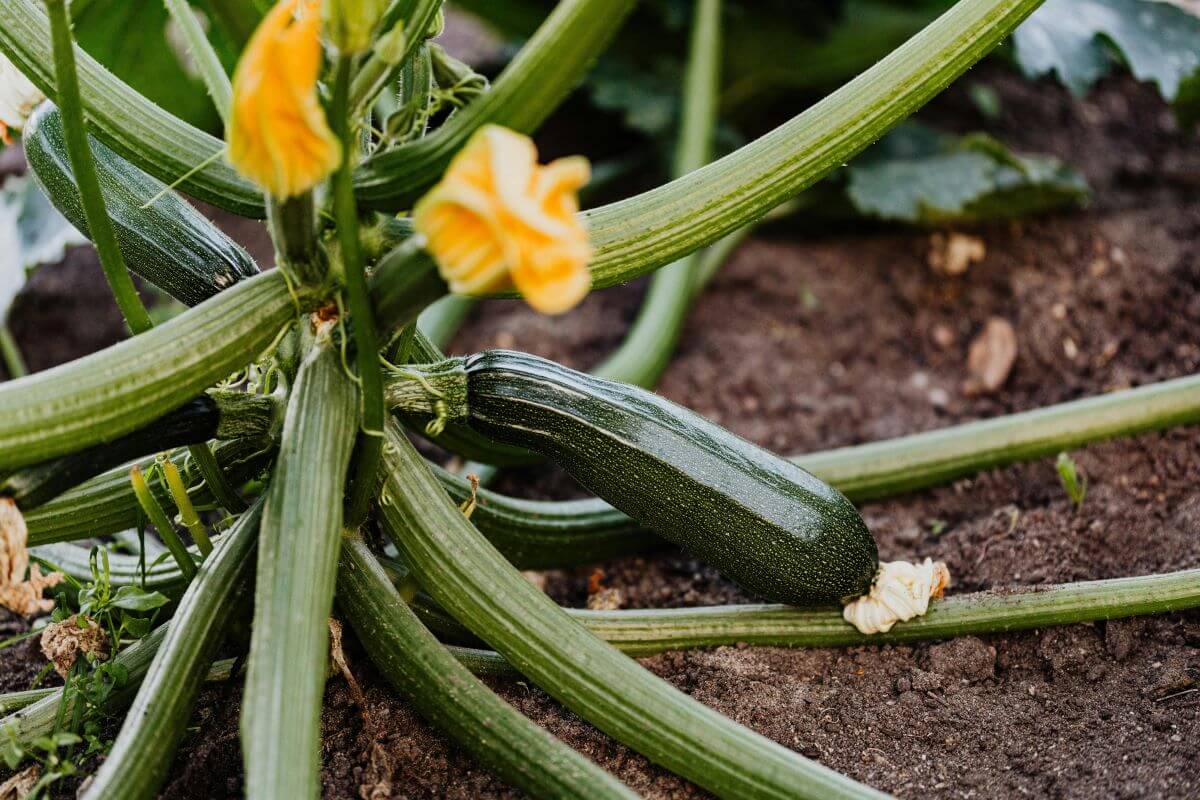
Also known as courgette or baby marrow, zucchini (Cucurbita pepo) is one of the versatile summer vegetables you can plant in your home garden. Under the right conditions, zucchini can yield bountiful harvest and provide countless culinary uses.
Technically, zucchini is a fruit, specifically, a berry. It is often treated as a vegetable in the kitchen, served as a side dish or used as an ingredient for savory recipes. From the common green summer squash to the striped varieties, learn more about this kitchen staple.
Common Zucchini Types
Growing your own zucchini at home allows you to access lesser-known varieties, and even ensure your crops are purely organic. Typical zucchinis have a smooth, green rind with an elongated shape. These varieties are widely sold in grocery stores for their desirable appearance.
However, other zucchini varieties come in different colors, shapes, and sizes. Before buying your zucchini seeds, it’s important to know the distinction between heirloom and hybrid zucchinis.
Heirloom and Hybrid Zucchinis
To be a considered heirloom, a particular plant variety should be at least 40 to 50 years free from crossbreeding. Among summer squash varieties, Black Beauty, Caserta, Cocozelle, Dark Green, Zucchini Golden, Zucchini Grey, and Zucchini Italian Striped are some of the most popular zucchini heirlooms. Being true-to-seed, these heirloom varieties are excellent for seed saving, carrying similar traits from the parent plant. Traditionally, heirloom varieties are passed down from generation to generation in various ethnic, familial, or other social groups. Private institutions, such as seed companies and universities, have also maintained certain heirloom plants.


Cash Machine, Desert, Easypick Gold II, Emerald Delight, Golden Star, and Noche are some of the most popular hybrid zucchinis. Through deliberate cross breeding between two zucchini varieties, agriculturists can imbue specific traits into the resulting hybrid. Improvements on disease resistance, flavor, growth, pest resistance, size, yield, and other traits can be made in hybrids.
Other Popular Zucchini Groupings
Classified by specific traits in the tables below, discover these zucchini varieties you can grow at home!
Types of Zucchini Skin Colors
Not all zucchinis have green exteriors. Other colors and patterns can be seen in some varieties.
Types of Zucchini Shapes
Zucchinis can have cylindrical, spherical, or other irregular shapes.
Types of Zucchini Flavors
Generally, zucchinis are mild in flavor. Some varieties are sweeter than others.
Types of Geographic Origins
Zucchini is believed to have originated in Mesoamerica, and later bred in Milan, Italy.
Types of Culinary Uses
Zucchini is a well-loved fruit for its many culinary uses. Most cooks treat the fruit as a vegetable.
Types of Disease Resistance
Some hybrid zucchinis are more resistant to certain plant diseases than others.
Types of Preferred Growing Conditions
Zucchinis with a bush-type growth are ideal for containers. Other varieties are more suitable for field or greenhouse planting.
Popular Varieties of Uniform-Colored Zucchinis


Most zucchinis sold commercially have uniform colors. Seeds for these varieties are also available in many seed stores.
| Variety | Description | Days to Germination | Days to Maturity After Flowering | Where to Buy |
|---|---|---|---|---|
| Black Beauty | Black Beauty is an All-America Selections winner due to its high-yielding capacity and vigorous plant growth. The resulting summer squash can reach 6 to 8 inches long with smooth, dark green skin and creamy-white flesh. | 4 to 14 days | 60 to 70 days | Eden Brothers, Territorial Seed Company, True Leaf Market, Rare Seeds |
| Early Prolific Straightneck | This bush-type zucchini variety grows bright yellow crops of about 6 inches long at best. Early Prolific Straightneck is an All-America Selections winner (from 1938) for its reliable productivity. If you’re looking for an early-season zucchini suitable for container planting, look no further. | 4 to 9 days | 45 to 50 days | Eden Brothers |
| Easypick Gold II | Easypick Gold II is a spineless summer squash variety that makes harvesting less challenging. It yields golden zucchinis and boasts intermediate resistance to papaya ringspot virus, and watermelon mosaic and zucchini yellow mosaic virus. | 5 to 10 days | 50 to 55 days | Territorial Seed Company |
| Cashflow Hybrid | Cashflow Hybrid is a bush-type zucchini with resistance to yellow mosaic virus. The green-skinned zucchini from this variety can give a hint of sweetness to stir-fry and roasts. | 10 to 14 days | 46 to 51 days | True Leaf Market |
| Fordhook | A bush variety, Fordhook produces crisp summer squash with dark green exterior and white flesh, reaching 6 to 8 inches long. Fordhook is a bush-type zucchini and works as a reliable producer of classic-looking zucchinis. | 7 to 14 days | 50 to 55 days | Eden Brothers, Rare Seeds |
| Golden Glory Hybrid | Golden Glory Hybrid is an incredible zucchini variety that can produce fruit with little to no presence of pollen. The resulting crop can reach 7 to 8 inches long with a golden exterior and creamy interior. This variety is a superior option if you’re mindful of quality and uniformity in your zucchinis. | 7 to 10 days | 53 to 58 days | True Leaf Market |
| Golden Star | For home gardeners with limited space, consider planting the summer squash variety, Golden Star. Compact and easy to manage, this disease-resistant hybrid zucchini grows golden crops 6 to 10 inches in length. | 7 to 14 days | 55 to 60 days | Territorial Seed Company |
| Yellowfin | Yellowfin has intermediate resistance to cucumber mosaic virus and powdery mildew. Due to these improvements, you can enjoy a long-season harvest of cylindrical, golden zucchinis. | 7 to 14 days | 50 to 55 days | Territorial Seed Company |
| Zucchini Golden | First introduced in 1973, Zucchini Golden is a bush-type summer squash variety that grows 10-inch-long crops at best. It is an excellent choice for home gardeners who are planting zucchinis for the first time. | 4 to 14 days | 55 to 65 days | Eden Brothers, True Leaf Market, Rare Seeds |
Popular Varieties of Striped Zucchinis


Prominent stripes can be found in some zucchinis, both green- and yellow-skinned varieties.
| Variety | Description |
Days to Germination | Days to Maturity After Flowering | Where to Buy |
|---|---|---|---|---|
| Cocozelle | Cocozelle is an Italian heirloom zucchini, first introduced in 1885. Its fruit can reach 10 to 12 inches. You can also harvest the blooms and fry them with batter. | 7 to 14 days | 48 to 53 days | Eden Brothers, True Leaf Market |
| Dario | Reaching up to 12 inches long under ideal conditions, Dario is a prolific option among home gardeners for its minimal seed count and crisp texture. It grows in a bush-like plant structure and has intermediate resistance to powdery mildew and watermelon mosaic virus. | 5 to 10 days | 50 to 55 days | Territorial Seed Company |
| Green Zebra | Green Zebra is a spineless, bush-type summer squash. The resulting crop from this variety works excellently in grilled recipes. | 7 to 14 days | 42 to 47 days | True Leaf Market |
| Sunstripe | About 7 inches long at best, Sunstripe displays a unique look with its bright yellow skin with cream stripes. Expect an effortless harvest as Sunstripe has a spineless, bush-type growth. | 4 to 10 days | 55 to 60 days | Territorial Seed Company |
| Vegetable Marrow Green Bush | Hailing from England, Vegetable Marrow Green Bush was first introduced in the 1800s. This tender-fleshed zucchini variety has a compact plant structure, making it suitable for container planting. | 5 to 7 days | 80 to 100 days | True Leaf Market |
| Zucchini Italian Striped | Zucchini Italian Striped can reach up to 12 inches with a dark green exterior and paler stripes. This variety is also referred to as Cocozelle Zucchini. | 7 to 10 days | 55 to 60 days | True Leaf Market |
FAQ About Types of Zucchinis
Which zucchini varieties are spineless?
For a scratch-free harvest, consider planting spineless zucchinis such as Black Beauty, Garden Spineless Zucchini F1, Golden Zebra F1, Green Zebra F1, and Zucchini Spineless Beauty.
Which zucchini varieties are ideal as pasta substitutes?
If you’re looking for a low-carb substitute to typical pastas, consider using zucchini. Varieties like Caserta, Cocozelle, and Zucchini Cashflow Hybrid are excellent options.








